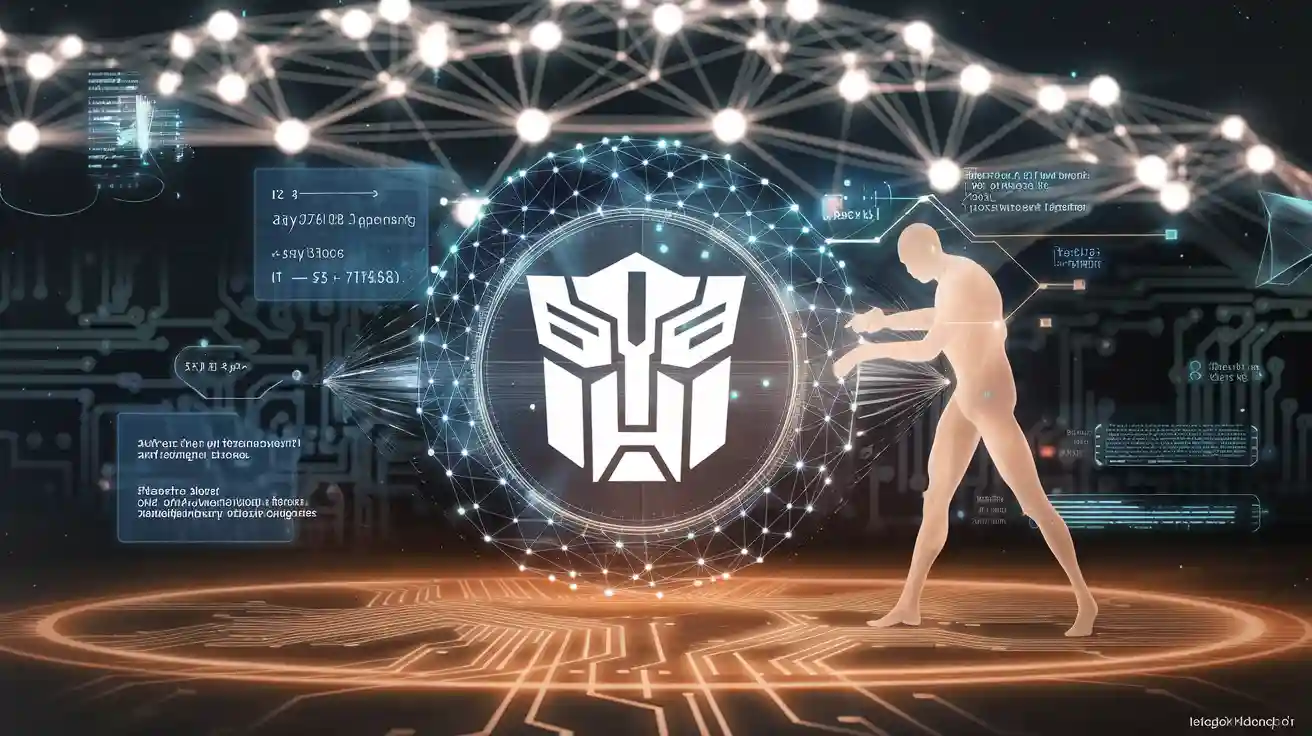
If you’ve ever wondered how AI can write essays, translate languages, or even generate images, you’ve already encountered the power of transformer models. These artificial intelligence models have transformed text processing and more. This beginner guide to transformer models will help you understand their basic architecture and why they’re a game-changer in AI.
Key Takeaways
-
Transformer models changed AI by using self-attention. This helps focus on key data, making tasks like translation faster and better.
-
The encoder-decoder setup helps transformers handle and create text well. This makes them great for language tasks and more.
-
Transformers work well in many areas, like vision and healthcare. They are flexible and can change how industries work.
Understanding Transformer Models
Definition and origin
If you're new to the world of AI, you might wonder, “What exactly are transformer models?” Simply put, they're a type of machine learning model designed to process and understand text, language, and other sequential data. Unlike older models, transformers rely on a unique mechanism called “attention” to focus on the most relevant parts of the input data. This makes them incredibly efficient and accurate.
The story of transformer models begins with the broader field of connectionist models. Back in 1990, Jeffrey Elman introduced the idea that time plays a crucial role in how humans process knowledge. Fast forward to 2017, and researchers introduced the transformer architecture, which revolutionized machine translation. By eliminating the need for recurrence and convolutions, this architecture made it possible to handle long sequences of text more effectively.
Here's a quick look at the key milestones in the history of transformers:
|
Year |
Event Description |
|---|---|
|
1990 |
Jeffrey Elman introduces concepts of connectionist models, emphasizing the importance of time in human behaviors and knowledge representation. |
|
2017 |
Introduction of the Transformer architecture, which utilizes attention mechanisms for improved machine translation efficiency and quality, eliminating the need for recurrence and convolutions. |
These breakthroughs laid the foundation for the powerful transformer models we use today.
Why they are revolutionary in AI
So, what makes transformer models such a big deal? For starters, they outperform traditional models like RNNs (Recurrent Neural Networks) in almost every way. Transformers are faster, more accurate, and better at handling complex tasks like question answering and language translation. They also scale well, meaning they can process massive amounts of text without breaking a sweat.
One of the biggest reasons transformers are revolutionary is their ability to focus on the most important parts of the input data. This attention mechanism allows them to understand context better than older models. For example, when translating a sentence, a transformer model can figure out which words are most relevant to the translation, even if they're far apart in the sentence.
To give you a clearer picture, here's how transformers stack up against traditional RNNs:
|
Metric |
Transformer Models |
Traditional RNNs |
|---|---|---|
|
Training Time |
Baseline |
|
|
Accuracy Improvement |
20-30% across NLP tasks |
Baseline |
|
Computational Complexity |
Significantly reduced for long-sequences |
Higher for long-sequences |
|
Accuracy in Complex Tasks |
Up to 40% higher |
Baseline |
As you can see, transformer models are not just an incremental improvement. They're a game-changer. Whether you're working on language translation, question answering, or any other text-based task, transformers offer unmatched performance and efficiency.
How Transformer Models Work
Encoder-decoder architecture
The encoder-decoder architecture is the backbone of many transformer models. Think of it as a two-part system where each part has a specific job. The encoder processes the input data, like a sentence in one language, and converts it into a set of meaningful representations. The decoder takes these representations and transforms them into the desired output, such as the same sentence translated into another language.
What makes this architecture special is its ability to handle complex tasks efficiently. Transformers excel in scalability and parallel processing, which means they can process long sequences of text faster than older models. They’re also great for smaller datasets and resource-constrained environments, making them versatile for different applications.
Here’s why the encoder-decoder architecture stands out:
-
It’s effective in handling smaller datasets without requiring massive computational resources.
-
Transformers leverage this architecture to scale up and process long sequences efficiently.
-
Parallel processing allows faster training and inference compared to traditional models.
This design is why transformer models have become the go-to choice for modern AI tasks like machine translation and text summarization.
Attention mechanism
The attention mechanism is the secret sauce that makes transformers so powerful. Imagine you’re reading a book and trying to understand a sentence. You naturally focus on the most important words to grasp the meaning. Transformers do the same thing, but they do it mathematically.
Attention helps the model figure out which parts of the input data are most relevant to the task at hand. For example, when translating a sentence, the model can pinpoint which words in the source language are crucial for the translation. This ability to focus on context improves accuracy and efficiency.
Here’s how attention has transformed AI:
-
It boosts predictive accuracy in tasks like gene expression and phenotype predictions.
-
It’s been used to predict complex biological interactions, such as ncRNA-disease associations.
-
Models with attention mechanisms have even enhanced the precision of CRISPR-Cas9 gene editing outcomes.
In simpler terms, attention allows transformers to understand relationships between words, even if they’re far apart in a sentence. This is why they’re so effective in tasks like language translation, text generation, and question answering.
Key Components of Transformers

Self-attention
Self-attention is the heart of the transformer architecture. It’s what allows transformer models to focus on the most important parts of the input text, no matter where they appear in a sequence. Imagine you’re reading a long paragraph. Instead of processing each word one by one, self-attention helps the model figure out which words are most relevant to understanding the meaning. This makes transformers incredibly efficient at tasks like text generation and language translation.
Here’s how self-attention proves its worth:
-
Researchers tested transformer models on datasets like WMT 2014 English-German and English-French, which include millions of sentence pairs.
-
The BLEU score, a metric for translation quality, showed that transformers outperformed older models.
-
Despite their superior performance, transformers required fewer computational resources, as measured by FLOPs (floating-point operations).
This mechanism is why transformers excel at handling long sequences of text while maintaining high accuracy and efficiency.
Positional encoding
Transformers don’t process text in order like humans do. Instead, they rely on positional encoding to understand the sequence of words. This technique assigns a unique position to each word, helping the model grasp the structure of the text. Without it, the model wouldn’t know if a word comes at the beginning, middle, or end of a sentence.
Different methods of positional encoding impact performance. For example:
|
Positional Encoding Method |
Configuration Type |
PESQ Scores |
ESTOI Scores |
|---|---|---|---|
|
Sinusoidal-APE |
Causal |
Similar to No-Pos |
Similar to No-Pos |
|
No-Pos |
Causal |
Same or better than Sinusoidal-APE |
Same or better than Sinusoidal-APE |
|
RPE |
Noncausal |
Significantly improved |
Significantly improved |
As you can see, advanced methods like RPE (Relative Positional Encoding) can significantly enhance the model’s ability to understand text structure.
Feedforward networks
Feedforward networks are the unsung heroes of the transformer architecture. These layers process the output of the attention mechanism, refining it to make better predictions. Think of them as the part of the model that turns raw insights into actionable results.
Research shows that feedforward layers play a critical role in transformer models. They make up about two-thirds of the model’s parameters and act as key-value memories. Lower layers capture simple patterns in the text, while upper layers learn complex relationships. This division of labor allows transformers to excel at tasks like text generation and language translation.
By combining self-attention, positional encoding, and feedforward networks, the transformer architecture becomes a powerful tool for processing and understanding text.
Types of Transformer Models
When it comes to transformer models, not all are built the same. Depending on their architecture and purpose, they fall into three main categories: encoder-only, decoder-only, and encoder-decoder models. Each type has its strengths and is suited for specific tasks. Let’s break them down.
Encoder-only models (e.g., BERT)
Encoder-only models focus on understanding text. They excel at tasks like sentiment analysis, named entity recognition, and other natural language understanding (NLU) applications. These models use a technique called masked language modeling, where certain words in a sentence are hidden, and the model predicts them based on context. This helps the model capture the meaning of words in relation to their surroundings.
For example, BERT (Bidirectional Encoder Representations from Transformers) is a popular encoder-only model. It’s great at grasping the nuances of text, making it ideal for tasks that require deep comprehension. However, these models generally perform lower in tasks that involve generating text, as they lack a decoding mechanism.
Decoder-only models (e.g., GPT)
Decoder-only models are the storytellers of the transformer world. They specialize in generating text, making them perfect for tasks like writing essays, answering questions, or even creating poetry. These models work by predicting the next word in a sequence, one step at a time. This process, called autoregressive modeling, allows them to produce coherent and contextually relevant text.
Take GPT (Generative Pre-trained Transformer), for instance. It’s one of the most well-known decoder-only models and powers many large language models today. Its ability to generate human-like text has made it a cornerstone in AI applications. In fact, models like GPT-4 have shown significantly better performance in tasks like question answering compared to encoder-only models.
Encoder-decoder models (e.g., T5)
Encoder-decoder models combine the best of both worlds. The encoder processes the input text, while the decoder generates the output. This makes them highly versatile, especially for tasks like translation, summarization, and text-to-text transformations.
T5 (Text-to-Text Transfer Transformer) is a prime example of an encoder-decoder model. It treats every task as a text-to-text problem, whether it’s translating a sentence or summarizing a paragraph. This unified approach simplifies training and makes the model adaptable to a wide range of applications.
Here’s a quick comparison of these transformer types:
|
Model Type |
Performance in NLU Tasks |
Learning Path Characteristics |
Top Models in Danish Leaderboard |
|---|---|---|---|
|
Encoder-only |
Generally lower |
Captures contextual information through masked language modeling |
N/A |
|
Decoder-only |
Significantly better |
Autoregressively predicts subsequent tokens, biased towards question answering |
GPT-4-0613, GPT-4-1106-preview, DanskGPT-Chat-Llama3-70B |
|
Encoder-Decoder |
N/A |
N/A |
N/A |
Understanding these types of transformer models helps you choose the right tool for your AI project. Whether you need to analyze text, generate it, or transform it, there’s a transformer architecture designed for the job.
Applications of Transformer Models in AI

Transformer models have revolutionized AI by excelling in various domains. From understanding human language to interpreting images and even advancing healthcare, these models have proven their versatility. Let’s explore some of their most impactful applications.
Natural language processing
Natural language processing (NLP) is where transformers truly shine. These models have transformed how machines understand and generate human language. Tasks like machine translation, text summarization, and question answering have become more accurate and efficient thanks to transformers.
For instance, models like BERT and GPT have set new benchmarks in NLP. They use attention mechanisms to focus on the most relevant parts of a sentence, improving their ability to understand context. This makes them ideal for tasks like sentiment analysis and named entity recognition.
Here’s a quick look at how transformer models perform in NLP tasks compared to traditional methods:
|
Model Type |
Training Sample Size |
|
|---|---|---|
|
BioBERT (Transformer) |
<1000 |
Poor performance |
|
Traditional NLP |
<1000 |
Better performance |
|
BioBERT (Transformer) |
1000-1500 |
Similar performance |
|
Traditional NLP |
1000-1500 |
Plateau in performance |
|
BioBERT (Transformer) |
>1500 |
Superior performance |
As you can see, transformers excel when trained on large datasets. They outperform traditional NLP methods, especially in tasks requiring deep contextual understanding. Whether you’re building a chatbot or analyzing customer feedback, transformers can take your NLP projects to the next level.
Computer vision
Transformers aren’t just for text—they’re making waves in computer vision too. Vision Transformers (ViTs) have shown remarkable performance in tasks like image classification, object detection, and image segmentation. They use attention mechanisms to analyze images, focusing on the most important features.
Here are some exciting ways transformers are used in computer vision:
-
Image Classification: Vision Transformers outperform traditional CNNs on large datasets by learning generalized representations.
-
Image Captioning: They generate descriptive captions for images, making categorization easier.
-
Image Segmentation: Intel’s DPT achieves 49.02% mIoU on ADE20K for semantic segmentation.
-
Anomaly Detection: Transformers detect and localize anomalies using reconstruction-based approaches.
-
Action Recognition: Google Research uses ViTs for video classification, extracting spatiotemporal tokens.
-
Autonomous Driving: Tesla integrates transformer modules for tasks like image-to-BEV transformation.
Transformers also excel in image generation and synthesis. They can create realistic images from text prompts, a process known as text-to-image generation. This has opened up new possibilities in fields like advertising, gaming, and art. Whether you’re working on autonomous vehicles or creating AI-generated art, transformers offer powerful tools for image-related tasks.
Other domains
Transformers have expanded beyond NLP and computer vision into other fields. Their ability to process sequential data makes them a general-purpose architecture for machine learning. In biology, for example, transformers simulate proteins and RNA with high accuracy. This has led to breakthroughs in drug discovery and genetic research.
In healthcare, transformers are improving clinical documentation, automating routine tasks, and enhancing decision-making. They help doctors analyze patient data more efficiently, leading to better outcomes. However, challenges like potential bias and ethical concerns need to be addressed.
Here are some notable applications of transformers in other domains:
-
Translating sentences and applying the same techniques to protein data.
-
Optimizing processes in healthcare, from data handling to patient empowerment.
-
Enhancing decision-making in industries like finance and logistics.
Transformers are also making strides in creative fields. Text-to-image generation and image synthesis are being used to create stunning visuals for movies, advertisements, and video games. These applications highlight the versatility of transformers and their potential to transform industries.
Challenges and Limitations of Transformers
Computational requirements
Training transformer models demands significant computational power. You might wonder why this is the case. It’s because transformers rely on complex operations, like self-attention, which require high-performance hardware such as GPUs or TPUs. These models process vast amounts of data, making them resource-intensive.
To give you an idea of the technical benchmarks involved, here’s a breakdown:
|
Metric |
Description |
|---|---|
|
Time-to-accuracy |
Measures the time taken to reach a certain level of accuracy during training. |
|
Throughput |
Evaluates the number of training samples processed per unit of time. |
|
Resource utilization |
Assesses how effectively the computational resources (CPUs, GPUs, TPUs) are being used. |
|
Energy efficiency |
Analyzes the energy consumption relative to the performance achieved during training. |
|
Scalability |
Examines how well the training process improves with the addition of more computational resources. |
|
Bottlenecks |
Identifies inefficiencies in the training process, such as memory bandwidth constraints. |
These metrics highlight the challenges of training transformers efficiently. While they deliver exceptional results, their computational requirements can limit accessibility for smaller organizations or individuals.
Scalability
Transformers excel at handling large datasets, but scaling them up comes with its own set of challenges. For instance, the self-attention mechanism has quadratic complexity with respect to sequence length. This means that as the input grows, the computational cost increases exponentially.
Here are some key scalability issues:
-
Computational Complexity: The quadratic nature of self-attention can make processing very long sequences impractical.
-
Positional Information: Transformers struggle with tasks that rely heavily on precise positional data due to their permutation-invariance.
-
Data and Compute Requirements: Training large models often requires enormous datasets and computational resources, which can impact the environment and limit accessibility.
-
Hybrid Models: Combining transformers with architectures like CNNs can improve efficiency and performance by leveraging the strengths of both.
Despite these challenges, researchers continue to explore ways to optimize scalability, such as developing more efficient attention mechanisms and hybrid approaches.
Ethical concerns
Transformers have revolutionized AI, but their deployment raises ethical questions. Bias in training data can lead to unfair outcomes, while objectionable content generated by models can harm users. For example, gender and racial biases often emerge in AI applications, reflecting societal inequalities embedded in the data.
Here’s a snapshot of documented ethical concerns:
|
Concern Type |
Percentage (%) |
|---|---|
|
Data Quality Concerns |
27.55 |
|
Gender Bias |
21.6 |
|
Cultural and Language Bias |
15 |
|
Racial Bias |
10 |
|
Occupational Bias |
5.8 |
|
Age Bias |
3.3 |
|
Religious Bias |
3.3 |
|
Disability Bias |
1.7 |
|
Generic Model Output Bias |
38.3 |
|
Objectionable Content (Rude) |
48.1 |
|
Objectionable Content (Sexual) |
23.1 |
As you can see, ethical concerns aren’t just theoretical—they’re backed by real-world statistics. Addressing these issues requires careful curation of training data and ongoing monitoring of model outputs. By prioritizing fairness and transparency, you can help ensure that transformers are used responsibly.
Transformer models have reshaped AI. Their self-attention mechanism captures context, while parallel processing boosts speed. They adapt to NLP, computer vision, and more. Here’s a quick recap of their impact:
|
Feature |
Impact |
|---|---|
|
Self-Attention Mechanism |
Captures context and long-range dependencies, improving NLP tasks. |
|
Parallel Processing |
Speeds up tasks and handles large datasets efficiently. |
|
Versatility Across Domains |
Powers applications in NLP, vision, and audio. |
|
Scalability and Evolution |
Drives the creation of advanced AI models. |
Explore transformers further—you’ll uncover endless possibilities!
FAQ
What makes transformer models different from traditional AI models?
Transformers use self-attention to focus on important parts of data. This makes them faster and better at understanding context compared to older models like RNNs.
Can transformers only work with text data?
Nope! Transformers also excel in computer vision, biology, and more. They analyze images, predict protein structures, and even assist in autonomous driving.
Do I need a supercomputer to train a transformer model?
Not necessarily. Pre-trained models like BERT and GPT are available. You can fine-tune them on smaller datasets using accessible hardware like GPUs.
💡 Tip: Start with pre-trained models to save time and resources!








